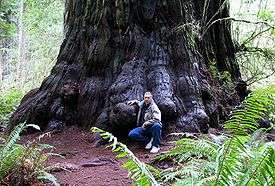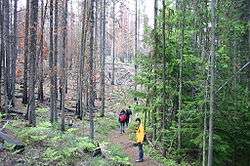Forest ecology
Forest Ecology is the scientific study of the interrelated patterns, processes, flora, fauna and ecosystems in forests. The management of forests is known as forestry, silviculture, and forest management. A forest ecosystem is a natural woodland unit consisting of all plants, animals and micro-organisms (Biotic components) in that area functioning together with all of the non-living physical (abiotic) factors of the environment.[1] The forest ecosystem is very important.
Relationship to other branches of ecology

Forest ecology is one branch of a biotically-oriented classification of types of ecological study (as opposed to a classification based on organizational level or complexity, for example population or community ecology). Thus, forests are studied at a number of organizational levels, from the individual organism to the ecosystem. However, as the term forest connotes an area inhabited by more than one organism, forest ecology most often concentrates on the level of the population, community or ecosystem. Logically, trees are an important component of forest research, but the wide variety of other life forms and abiotic components in most forests means that other elements, such as wildlife or soil nutrients, are often the focal point. Thus, forest ecology is a highly diverse and important branch of ecological study.
Forest ecology studies share characteristics and methodological approaches with other areas of terrestrial plant ecology. However, the presence of trees makes forest ecosystems and their study unique in numerous ways.
Community diversity and complexity
Since trees can grow larger than other plant life-forms, there is the potential for a wide variety of forest structures (or physiognomies). The infinite number of possible spatial arrangements of trees of varying size and species makes for a highly intricate and diverse micro-environment in which environmental variables such as solar radiation, temperature, relative humidity, and wind speed can vary considerably over large and small distances. In addition, an important proportion of a forest ecosystem's biomass is often underground, where soil structure, water quality and quantity, and levels of various soil nutrients can vary greatly.[2] Thus, forests are often highly heterogeneous environments compared to other terrestrial plant communities. This heterogeneity in turn can enable great biodiversity of species of both plants and animals. It also affects the design of forest inventory sampling strategies, the results of which are sometimes used in ecological studies. A number of factors within the forest affect biodiversity; primary factors enhancing wildlife abundance and biodiversity are the presence of diverse tree species within the forest and the absence of even aged timber management.[3] For example, the wild turkey thrives when uneven heights and canopy variations exist and its numbers are diminished by even aged timber management.
Energy flux
Forests accumulate large amounts of standing biomass, and many are capable of accumulating it at high rates, i.e. they are highly productive. Such high levels of biomass and tall vertical structures represent large stores of potential energy that can be converted to kinetic energy under the right circumstances. Two such conversions of great importance are fires and treefalls, both of which radically alter the biota and the physical environment where they occur. Also, in forests of high productivity, the rapid growth of the trees themselves induces biotic and environmental changes, although at a slower rate and lower intensity than relatively instantaneous disturbances such as fires.
Death and regeneration
Woody material, often referred to as coarse woody debris, decays relatively slowly in many forests in comparison to most other organic materials, due to a combination of environmental factors and wood chemistry (see lignin). Trees growing in arid and/or cold environments do so especially slowly. Thus, tree trunks and branches can remain on the forest floor for long periods, affecting such things as wildlife habitat, fire behavior, and tree regeneration processes.
Water
Lastly, forest trees store large amounts of water because of their large size and anatomical/physiological characteristics. They are therefore important regulators of hydrological processes, especially those involving groundwater hydrology and local evaporation and rainfall/snowfall patterns.[4] Thus, forest ecological studies are sometimes closely aligned with meteorological and hydrological studies in regional ecosystem or resource planning studies. Perhaps more importantly the duff or leaf litter can form a major repository of water storage. When this litter is removed or compacted (e.g. through grazing or human overuse), erosion and flooding are exacerbated as well as deprivation of dry season water for forest organisms.
Ecological potential of forestal species
The ecological potential of a particular species is a measure of its capacity to effectively compete in a given geographical area, ahead of other species, as they all try to occupy a natural space. For some areas it has been quantified, as for instance by Hans-Jürgen Otto, for central Europe.[5] He takes three groups of parameters:
- Related to site requirements: Tolerance to low temperatures, tolerance to dry climate, frugality.
- Specific qualities: Shade tolerance, height growth, stability, longevity, regeneration capacity.
- Specific risks: Resistance to late freezing, resistance to wind/ice storm, resistance to fire, resistance to biotic agents.
Every parameter is scored between 0 and 5 for each considered species, and then a global mean value calculated. A value above 3.5 is considered high, below 3.0 low, and intermediate for those in between. In this study Fagus sylvatica has a score of 3.82, Fraxinus excelsior 3.08 and Juglans regia 2.92; and are examples of the three categories.
See also
- Clearcutting
- Close to nature forestry
- Intact forest landscapes
- Mountain ecology
- Old-growth forest
- Deforestation and climate change
References
Notes
- ↑ Robert W. Christopherson. 1996
- ↑ James P. Kimmins. 2004
- ↑ Philip Joseph Burton. 2003
- ↑ Smerdon, Brian D, et al., (2009). "An overview of the effects of forest management on ground water hydrology" (PDF). BC Journal of Ecosystems and Management. 10 (1): 22–44.
- ↑ Otto, Hans-Jürgen (1998). Écologie Forestière (in French). Paris: Institut pour le Développement Forestier. ISBN 9782904740657.
Bibliography
- Philip Joseph Burton. 2003. Towards sustainable management of the boreal forest 1039 pages
- Robert W. Christopherson. 1996. Geosystems: An Introduction to Physical Geography. Prentice Hall Inc.
- C. Michael Hogan. 2008. Wild turkey: Meleagris gallopavo, GlobalTwitcher.com, ed. N. Stromberg
- James P. Kimmins. 2004. Forest Ecology: a foundation for sustainable forest management and environmental ethics in forestry, 3rd Edit. Prentice Hall, Upper Saddle River, NJ, USA. 611 pages
